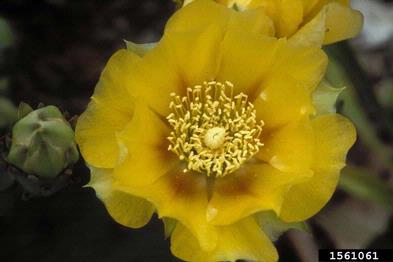Pricklypear
Opuntia humifusa
Family: Cactaceae
Natural History

Flower of pricklypear
Photo credit: Catherine Herms, The Ohio State University, Bugwood.org
Pricklypear, also called Indian fig, is the only widespread eastern cactus. Like its western cousins, pricklypear retains moisture in its thick pads and is able to survive in very dry environments. It produces a showy flower and edible fruit.
Songbirds and small mammals seek shelter in spiny dens surrounded by the plant's stems and pads. Raccoons and gopher tortoises have been seen eating the pads and fruits. Pricklypear fruit and seeds are consumed by quail, wild turkey, doves, thrashers and woodpeckers, along with many mammals, such as fox, squirrel and rabbit. White-tailed deer use the plants as a springtime browse.
Animals are not the only ones to eat the sweet pricklypear fruit. Peeled, sliced and sprinkled with lemon, the berries are said to have an enjoyable, sweet-tart taste. The fruits and pads may also be cut up and used as a low-calorie addition to salads. Pricklypear is a good source of potassium and fiber and also contains significant amounts of calcium and vitamin A.
The pricklypear protects itself with more than just the obvious sharp spines. Tufts of short, fine, hair-like spines cover the nodes and fruit, and can easily get into your skin and cause irritation.
Several varieties of pricklypear grow throughout the United States on poor, dry, sandy soil. The southeastern version of pricklypear grows from Florida to Massachusetts, and west to Michigan and Oklahoma.
